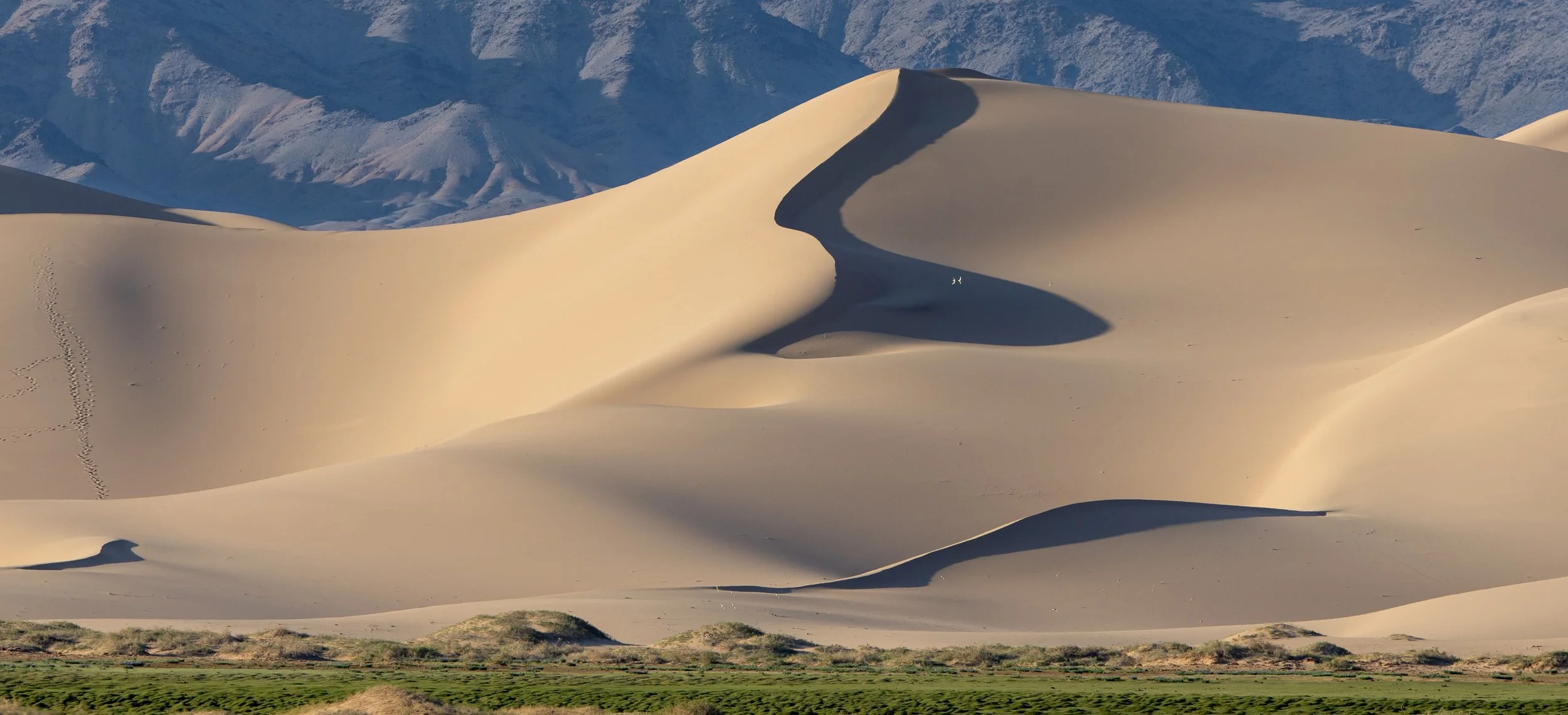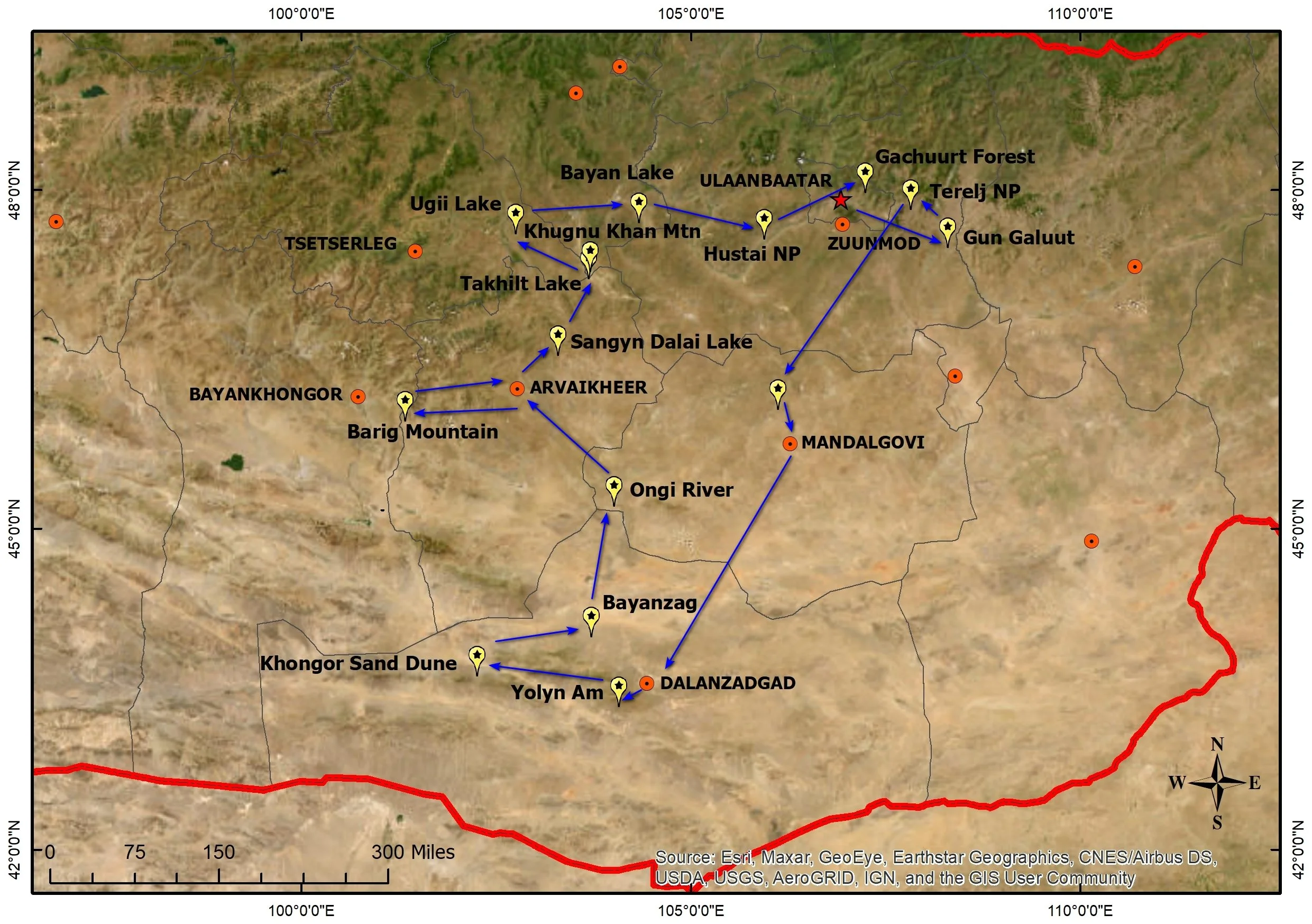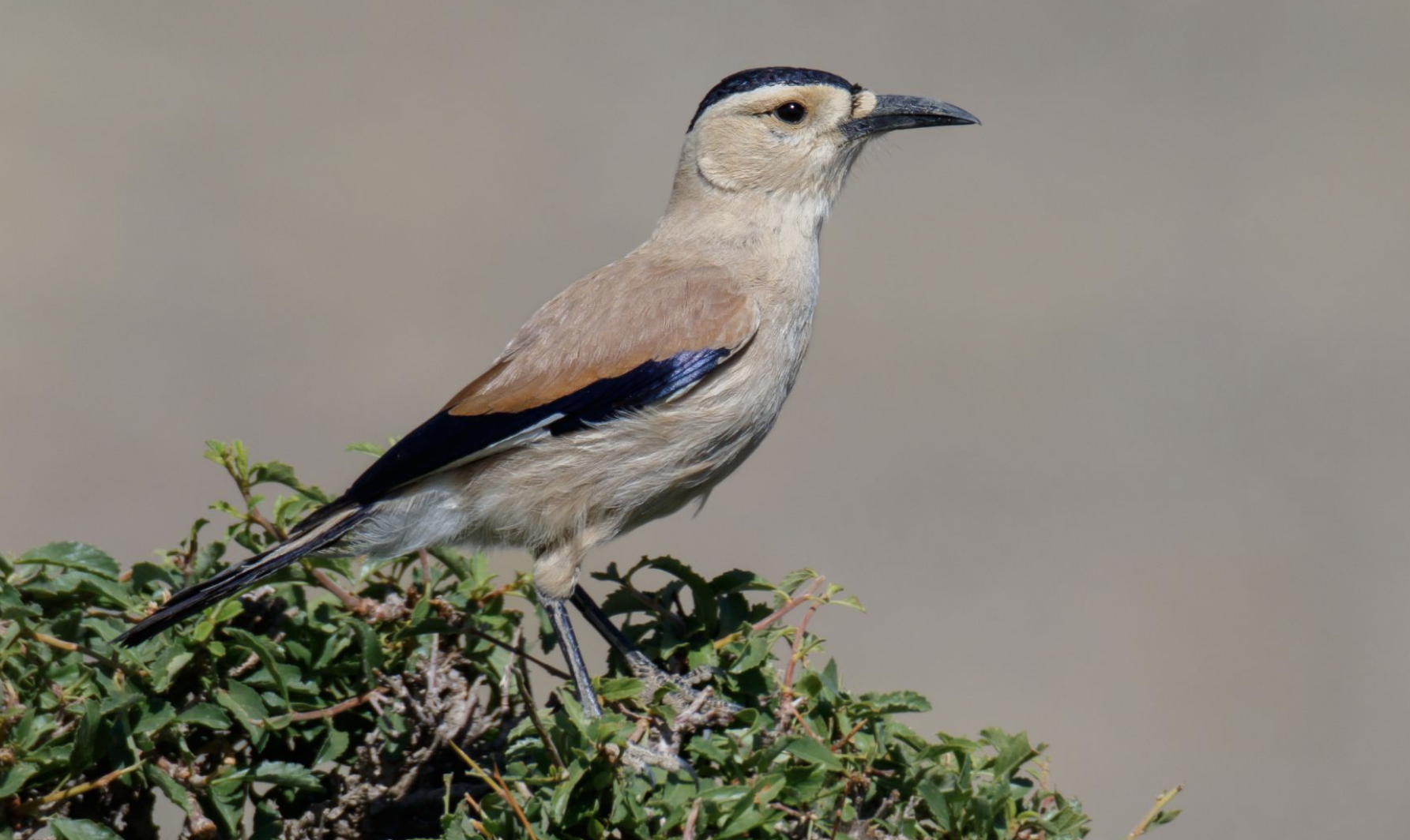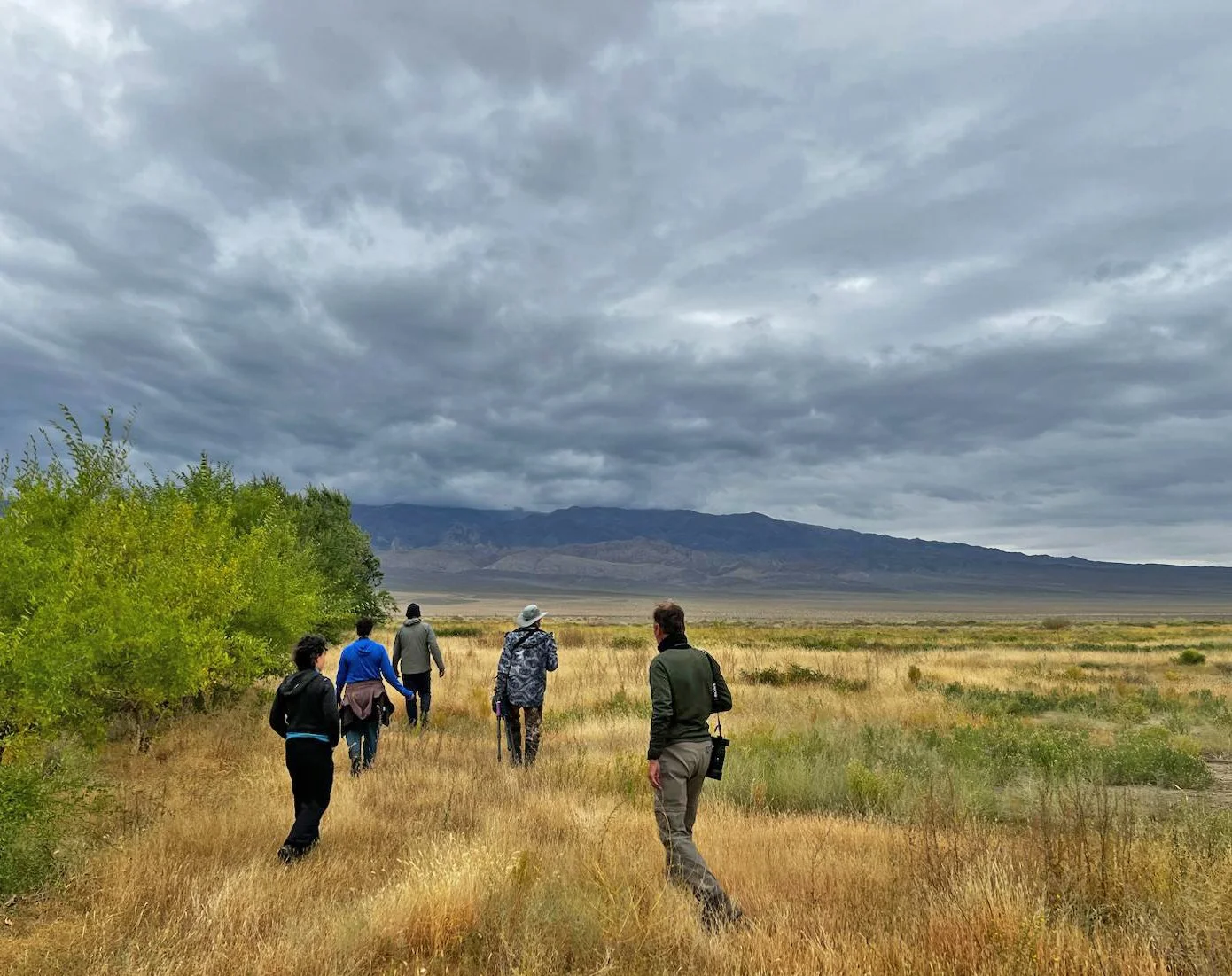
The Khongor Sand Dune in the Gobi Desert by Louis Bevier
If vast open spaces tug at your heart, then Mongolia has done the same. The “Land of the Eternal Blue Sky” is nearly the size of Alaska, yet has a population about that of Los Angeles. This makes it the most sparsely populated country on the planet. About 25% of the population still live the nomadic lifestyle for which the country is famous. It is said there are more horses than people in Mongolia. Half of the people live in the capital, Ulaanbataar, and even here one is near to nature. Just south of town is the world’s first national park (protected in 1783).
For nature lovers and birders, there are few places more spectacular. Endless empty blue skies during the day burst with starlight at night. When spring migration is underway and the breeding season is kicking off, Mongolia offers the best birding in Central Asia. Famed for its awe-inspiring expanses, we visit the Gobi Desert in the south, camp comfortably amidst the steppes and grasslands, and explore the forests and mountains of the north. With a few hotels mixed in, mostly we hop-scotch from one campground to the next, remaining in wilderness, and are thus well positioned to absorb the serene and stark beauty of the unique landscape, and to see its feathered gems.
Join us as we seek out Black-billed Capercaillie, the dapper Oriental Plover, the rare White-throated Bushchat, Mongolian Lark and the odd Mongolian Ground-Jay. Along the way we will also try to see Swan Goose, Bearded Vulture, Wallcreeper, Azure Tit, and so much more.
Tour Features
Boundless horizons, intensely scenic landscapes, and dramatic night skys.
Prolonged time in wilderness, as we hopscotch from one remote, scenic camp site to the next.
Sparsely populated landscape with a living tradition of nomadism and equestrian culture.
A leader in conservation, the nation is on target to protect 30% of its land by 2030.
Seldom observed Central Asian species and iconic birds, such as Beautiful Rosefinch, White-naped Crane, Stejneger’s Scoter, Lammergeier, Wallcreeper, Altai Accentor & others.
Fascinating mammals, with good chances to see Przewalski’s Horse (Takhi), Mongolian Gazelle, Asiatic Wild Ass (Onager), Corsac Fox & more.
Tour Plan
Day 1. Arrive into Ulaanbaatar on May 21st, & night there.
Day 2. Drive to Gun Galuut Nature Reserve, night in Steppe ger Camp.
Day 3. Drive to Terelj National Park, night in Khadag ger Camp.
Day 4. Terelj to Baga Gazryn Chuluu, night at Gobi ger Camp.
Day 5. Birding our way to Yolyn Am, night at Khanbogd ger Camp.
Day 6. The Khongor Sand Dune, night at Khanbogd ger Camp.
Day 7. Bayanzag (Flaming Cliffs) & Saxaul Forest, night at Mongol Gobi ger Camp.
Day 8. Bayanzag to the Ongi River, night at Ongi ger camp.
Day 9. Ongi River - Arvaikheer, night at the Bogd Hotel.
Day 10. Birding Barig Mountain, night at the Bogd Hotel.
Day 11. Takhilt Lake & Khugnu Khan Mountain, Khan ger camp.
Day 12. Takhilt Lake to Ugii Lake, night at Ugii Khishig ger camp.
Day 13. Bayan Lake & Hustai National Park, night at Hustai ger camp.
Day 14. Birding Hustai National Park, night at Hustai ger camp.
Day 15. Hustai NP to Gachuurt Forest, night at G Hotel.
Day 16. Gachuurt Forest to Ulaanbaatar, night in Ulaanbaatar.
Day 17. Depart for points home on 6th of June.
Hotspots
Gun Galuut Nature Reserve
About 80 miles southeast of UB, the Gun Galuut NR offers a good diversity of habitats, with mountains, expansive steppes, rivers, lakes and wetlands. We visit one wetland where the rare White-naped Crane typically breeds, and also see several lakes that often hold waterfowl and waders. With luck we could encounter birds such as Demoiselle Crane, Stejneger’s Scoter, or Père David's Snowfinch, a regional special of the natural grasslands here. For mammals there are a number of rodents we could see, and fortunate visitors could see Gray Wolf or Argali (Mountain Sheep).
Terelj National Park
Just 66km (41 miles) north of Ulaanbaatar (UB), nestled into the Terelj River valley lies this national park and birding hotspot, considered one of the most scenic areas in Mongolia. Here, we hope to connect with the Black-billed Capercaillie. A bird of larch forests, the males gather in select spots to display for females. We’ll need some luck to encounter them and we’ll listen for their odd crackling, popping call, but with some luck we could connect with this extremely large grouse. As we go, we’ll also keep eyes peeled for Taiga Flycatcher, Pine Bunting, Red-throated Thrush, Two-barred Greenish Warbler and Daurian Jackdaw. But a small fraction of the park is open to the public, others are drawn here for rock-climbing, the scenery, the hot springs, and the lake. Parts of it host Brown Bears.
Gobi Gurvan Saikhan Mountains & Yolyn Am
Among the nation’s newest and its largest national park, the Gurvan Saikhan Mountains are known as “The Three Beauties” for the three scenic if smaller subranges that comprise the Gurvan Saikhan. Well known as a dwelling place for Argali and Siberian Ibex, we shall visit the unique Yolyn Am. Resting within the Zuun Saikhanii Nuruu (the Eastern Beauty) subrange, “Yol” is the Mongolian word for the Bearded Vulture (or Lammergeier), and thus this is “the Valley of the Vultures”. While we hope to bump into this bird somewhere along the way, we also seek Wallcreeper, Godlewski’s Bunting, Mongolian Accentor, Beautiful Rosefinch, Barred Warbler, and Sulphur-bellied Warbler. Yolyn Am is known for its ice field which by the end of winter may be several meter thick and several kilometers long. In route to the park, we will seek the dashing Oriental Plover, and hit a couple migrant hotspots.
The Gobi Desert & Khongor Sand Dune
The Gobi is the 6th largest desert in the world, bigger than Texas and California combined. It is a rather diverse desert, exhibiting a variety of habitats. Resting in the southern reaches of the Gobi, stretching up to 7 miles wide, 62 miles long, and rising up several hundred feet high, is Khongoryn Els, the Khongor Sand Dune, also called Duut Mankhanor the "Singing Sands". Due to wind, the enormous dunes here continually shift and re-shape, releasing small avalanches, and emitting a resonant sound, that sounds sort of like a plane taking off in the distance. On the way to the dune, we will look for rare mammals such as Asiatic Wild Ass (a.k.a. Onager), Goitered Gazelle and Mongolian Gazelle. Nearby we’ll explore hilly areas to look for Mongolian Ground-jay, and we will hit a small patch of Saxaul forest (Saxaul is a shrub/tree in the Amaranth family) to try and see Saxaul Sparrow, while looking too for Asian Desert Warbler, Southern Grey Shrike, Desert Wheatear, and Long-legged Buzzard.
Bayanzag (Flaming Cliffs)
Named for their crimson glow at sunset, the sandstone Flaming Cliffs were so named by paleontologist Roy Chapman Andrews of the American Museum of Natural History (alleged by as the inspiration for “Indiana Jones”), who found the first-ever fossilized dinosaur eggs in the region. He also discovered Velociraptor specimens here as well as several other significant specimens. For us, this area will be mostly sightseeing but with a little birding in the Saxual forest perhaps including Saxual Sparrow, Pallas’s Sandgrouse, Mongolian Accentor or others.
Barig Mountain
A remote birding site, but one that offers us our best chance at connecting with the rare White-throated Bushchat. Also known as Hodgson's Bushchat, this is a vulnerable and declining species numbering perhaps as few as just a couple thousand individuals total. Breeding only sparsely in Mongolia and Russia, and wintering at threatened grassland sites within the Himalayas, it is seldom seen. We’ll need luck to find it, but this is a good area for the species and we could also connect with migrants like Black-faced Bunting, Little Bunting, Ortolan Bunting, Pallas’s Bunting, Siberian Rubythroat, or others.
Bayan Lake & Takhilt Lake
Two remote, beautiful lakes and well known birding spots, known as locations for threatened Dalmatian Pelican, Pallas's Fish-Eagle, and Saker Falcon. Other raptors are possible too such as Cinereous Vulture and Upland Buzzard, and we hope to find reedbed specialists and wetland birds like Pallas’s Reed Bunting, Bearded Tit, Eastern Yellow Wagtail, Oriental Reed Warbler, Paddyfield Warbler, Pallas’s Grasshopper Warbler, Eastern Marsh Harrier and White-naped Crane.
Hustai National Park
Established in 1993 to protect reintroduced Przewalski’s Horse, this park is a wonderful mix of forest, steppe, grasslands, and sand dunes. The horse, known locally as Takhi, is considered to be the only remaining wild horse species in the world. Once widespread across the steppes of western Europe and Asia, since the mid 1900s it has been confined just to Mongolia’s Gobi region. The park also supports other mammals such as elk, Tarbagan Marmots and out on the steppes of the park, Mongolian Gazelles. We’ll keep an eye out for raptors and could see Golden Eagle, Steppe Eagle, Saker Falcon, Amur Falcon, and other birds like Daurian Partridge, Meadow Bunting and the handsome Mongolian Lark.
Gachuurt Forest & UB Outskirts
The forests outside of Ulaanbaatar can have Hazel Grouse, Siberian Jay, Eurasian Three-toed Woodpecker, Eurasian Goshawk by the end of our trip some new spring arrivals may have pitched in, like Chinese Bush Warbler. We’ll also keep an eye out here for Siberian Rubythroat, Black-faced Bunting, Dusky Warbler and even possibly Gray-headed Tit. Nearby the Tuul River can sometimes offer encounters with Azure Tit, White-crowned Penduline Tit, Amur Falcon, Long-tailed Rosefinch, Azure-winged Magpie and White-cheeked Starling.
Rigor & Pace
Mongolia represents a vast an open country and we will cover a lot of ground. We will spend a good amount of time birding by foot, but also a good amount of time birding by car, while covering some distance. There are several days with long drives, sometimes of 250 miles in a day and this could include some time on rough roads. Mostly we travel in 4x4 SUVs, like Toyota Land Cruisers. Luckily we can see birds almost anywhere as we go. But there are a couple days of prolonged driving (4+ hours).
Most accommodations are in yurts (also called “gers”). Mongolia is sparsely populated with few options for places to stay away from the capital, UB. The camps are comfortable and well located for scenery, birds and wildlife, but not luxurious. We mix in a few hotels too, particularly in UB, and with one also mid-tour. Camping spaces are limited such that single occupancy yurts are also limited. If you wish for a single room in the hotels, that can be arranged but for single space while in ger camps, please inquire with us and we can see if a single ger is possible
Weather is quite variable in May/June, though normally is warm or even hot during the day. At night it cools down and often remains so early in the morning. On the days when we are higher up, it can be chilly. Rain and even snow are possible.
There is little hiking or strenuous activity during this trip. Mostly we are on flat terrain and when on foot are going at a reasonable (birder’s) pace, but there may be days when we spend several 3-5 hours on foot. There may be a couple of options for more strenuous hikes in places where there is time for it, but this would be optional.
Food choices in Mongolia are more limited than in many countries, and so it is a challenging place for people who cannot abide meat in their diet. Vegetarian meals may be possible at some spots, but at others vegetarian meals are unlikely or impossible. A strictly vegan diet would be very difficult or impossible to accommodate.
PRICE & BOOKING INFO
Tour Price/person*: $8175/person sharing
Deposit: $1000/person
Single supplement: limited availability (inquire if you desire a single room/tent, see “Rigor & Pace”)
Final Payment Due: January 21, 2027
Group size: 5 to 12 guests
Hillstar Nature strongly recommends all guests purchase travel insurance that covers Trip Cancellation, Trip Curtailment, Trip Interruption, and Emergency Medical and Medical Evacuation.
*Based on double occupancy at lodgings, with a group size of 5 to 12 registrants. Maximum group size is 12 registrants, plus guide(s) and driver(s). If there are fewer than 5 registrants, this tour may be cancelled or re-negotiated.
The tour price (fee) includes:
All accommodations from Day 1 until Day 16.
All meals from dinner on Day 1 through breakfast on Day 16.
All transportation from airport pick-up on Day 1 to airport drop-off on Day 16.
All guiding services, access permits and entrance fees to birding areas included.
Tips for drivers and staff at hotels and restaurants.
Excluded from your tour fee are:
International arrival and departure flights.
Alcoholic beverages
Personal expenses such as laundry services, charges for phone calls, additional expenses associated with travel such as insurance, visa fees, airport taxes, airline baggage fees, COVID tests, vaccinations, etc.
Tips for local guide/escort (recommended $5 to $10/day/person).
Documents
All travelers must have a current passport, valid for six months beyond the start date of this tour, with at least one blank page for visas.
CANCELLATION POLICY
Please review Hillstar Nature’s Terms and Conditions of Booking. If a guest/participant cancels registration:
● 120 days or more prior to the start of the tour, a refund is issued minus a $500/person processing fee.
● Between 119 and 90 days prior to the start of the tour, half of the tour fee will be returned to the registrant.
● 89 days or less prior to departure, no refund of payments or deposits are issued.

Sunset at Boon Tsagaan Lake by Louis Bevier










